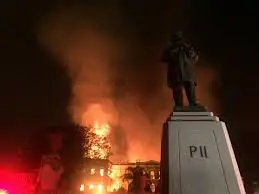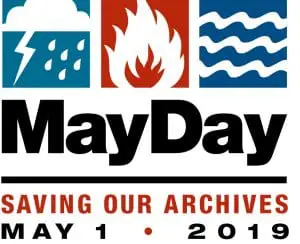It’s MayDay: Are Your Archives Safe?
Search “May Day” on the internet and you’ll find descriptions of centuries of Spring celebrations (including a peculiar little outdoor soiree where cattle had to jump over fire to protect their milk from being stolen by fairies), the canonization of Saint Walpurga, the crowning of Queen Mary, the maypole, International Workers’ Day and a myriad of other associations that can lead to a lost hour (or more) of trivia pursuit.
Put the words “MayDay” together and in the space of, well, a space, one moves from festivity to tragedy. The origin of “MayDay” as an international distress signal is most likely an English version of the French words m’aidez or m’aider, which mean “help me.” It signals a life-threatening emergency and appears to have been first used in 1923 by Frederick Mockford, a senior radio office at Croydon Airport in London, and made official in 1948.
Having recently witnessed catastrophic fires at Notre Dame and the National Museum in Rio de Janeiro and the flooding destruction of so many university, courthouse and library collections and records due to Hurricane Florence – just to name a very few disasters – the potential loss of irreplaceable history is front and center in the minds of those tasked with finding, protecting and preserving archives.

In our industry, “MayDay” has been designated by the Society of American Archivists (SAA) as a day to “take responsibility for doing something simple—something that can be accomplished in a day but that can have a significant impact on an individual’s or a repository’s ability to respond to an emergency.”
A list of ideas for MayDay activities from SAA includes:
- Create or update contact lists
- Review or establish basic emergency procedures
- Conduct a disaster drill
- Conduct scenario exercises
- Invite local firefighters to visit your repository
- Survey the building for risks
- Make sure all collections are in boxes (and off the floor)
- Identify the most critical, essential, important records
- Inventory emergency supplies
- Review or create an emergency preparedness plan
And One More Idea: Digitize
Not surprisingly, we would add digitize your collections to the list. For critical records and cultural heritage collections, this is one area where the cost to execute is far less than the cost of NOT digitizing. Archive scanning is very feasible. Enhancements in digital technology have led to both affordability in scanning systems and resolution quality that can mimic an original. A digital file can never be a replacement, but it can be a recording of the most minute details, capturing an image for preservation, continuing research and enhanced accessibility now and in the event of an emergency.
So today, on May Day, take a minute to think “MayDay” and take something off of the list above to ensure that your records and archives – be they personal collection or world treasure – are safe from unexpected disaster.
Need help with a MayDay plan?
With nearly forty years of analog and digital experience, The Crowley Company offers high-quality production and cultural heritage scanning systems, scanning services and technical collection assessment. To find out how we might help with a MayDay (or every day) solution, please call (240) 215-0224 or contact us for more information.


